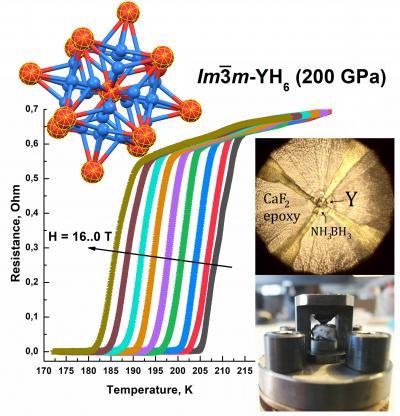Mar 11 2021
An international team of researchers has carried out experimental and theoretical studies on a new high temperature superconductor, yttrium hydride (YH6).
 Scientists have synthesized a new high temperature superconductor. Image Credit: Ivan A. Troyan, et al./Advanced Materials.
Scientists have synthesized a new high temperature superconductor. Image Credit: Ivan A. Troyan, et al./Advanced Materials.
The results of the study, which was led by Artem R. Oganov, a Professor at Skoltech and MISIS, and Dr. Ivan Troyan from the Institute of Crystallography of RAS, were published in the Advanced Materials journal.
Until now, Yttrium hydrides grade among the three known highest temperature superconductors. The leader among the three is a material with an unfamiliar S-C-H composition and superconductivity at 288 K.
The second one is lanthanum hydride, LaH10, superconducting at temperatures up to 259 K, and the third one is yttrium hydrides, YH6 and YH9, with maximum superconductivity temperatures of 224 K and 243 K, respectively.
In 2015, Chinese scientists predicted the superconductivity of YH6. All of these hydrides attain their optimum superconductivity temperatures at very high pressures: 2.7 million atmospheres for S-C-H and around 1.4-1.7 million atmospheres for YH6 and LaH10. The need for high pressure remains a significant barrier for quantity production.
Until 2015, 138 K (or 166 K under pressure) was the record of high-temperature superconductivity. Room-temperature superconductivity, which would have been laughable just five years ago, has become a reality. Right now, the whole point is to attain room-temperature superconductivity at lower pressures.
Dmitry Semenok, Study Co-Author and PhD Student, Skolkovo Institute of Science and Technology
First, the highest temperature superconductors were proposed in theory and then made and examined experimentally. When new materials are analyzed, chemists begin by making theoretical hypotheses and then test the new material practically.
First, we look at the bigger picture and study a multitude of different materials on the computer. This makes things much faster. More detailed calculations follow the initial screening. Sorting through fifty or a hundred materials takes about a year, while an experiment with a single material of particular interest may last a year or two.
Artem R. Oganov, Professor, Skolkovo Institute of Science and Technology
In general, critical superconductivity temperatures are estimated by theory with an error of around 10% to 15%.
Similar precision is realized in crucial magnetic field predictions. With respect to YH6, theory and experiment do not agree so well.
For instance, the critical magnetic field noted in the experiment is 2 to 2.5 times greater than theoretical estimates.
For the first time, researchers have observed such a disparity, which has not been explained yet. Other physical effects probably contribute to the superconductivity of this material and were not accounted for during theoretical calculations.
Journal Reference:
Troyan, I. A., et al. (2021) Anomalous High‐Temperature Superconductivity in YH6. Advanced Materials. doi.org/10.1002/adma.202006832.